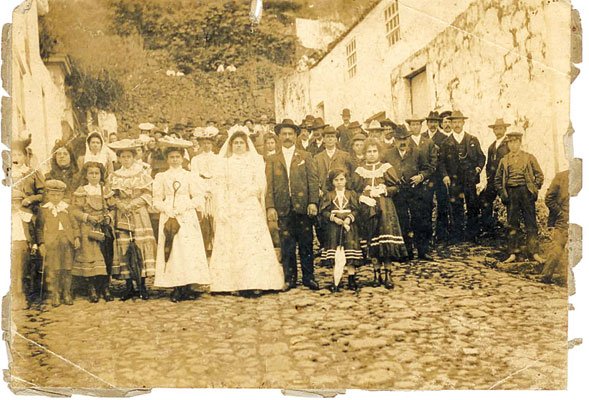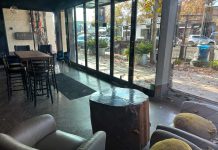As a fourth generation only child, I have no aunts, uncles,
nieces, nephews, cousins, or siblings of my own. Maybe that
explains why I am so fascinated by the family of Gilroy’s Carmen
Silva, an immigrant from the Azores.
As a fourth generation only child, I have no aunts, uncles, nieces, nephews, cousins, or siblings of my own. Maybe that explains why I am so fascinated by the family of Gilroy’s Carmen Silva, an immigrant from the Azores.
Carmen Silva has 48 maternal first cousins, and when she mentioned the extraordinary family reunion they’ve been having this past year, I had to know more.
Carmen Silva – who co-owns Accent Tile & Marble with her husband, Roger Silva – was born on the island of Sao Jorge where the family business was making specialty cheeses.
The Azores are located midway between the eastern coast of the United States and mainland Portugal – scattered over several hundred miles of Atlantic Ocean.
The archipelago of nine islands sits at the very spot where the tectonic plates for Europe, Africa and North America meet. A volcanic eruption in 1957, along with the damage it wreaked, led many Azorian immigrants to seek refuge in other European countries as well as the United States.
When President John F. Kennedy passed the Family Reunification Act in 1962, it enabled families with relatives in the U.S. to be reunited with relatives from the Azores, and Carmen Silva’s family followed in the footsteps of an aunt who had immigrated to America. Her family arrived in the U.S. Feb. 11, 1969, when Carmen Silva was a young girl.
“We came with nothing but the power of the American dream and a strong sense of family in our hearts,” she said.
As other Azoreans immigrated in the 1970’s, there were lots of big family weddings.
“Think of ‘My Big Fat Greek Wedding,'” Carmen Silva described. “We had five or six weddings each summer. We couldn’t wait to get to the reception afterwards – we always had a cousins’ table. We created havoc, but it was all in good-natured fun!”
At first maintaining close ties, eventually the more extended parts of the family went their separate ways and gradually lost touch. Until a year ago in November, when one of the cousins had a child who was marrying and decided to invite the entire family again.
“Should we have a cousins’ table?” someone asked, and it was like old times. Getting the original cousins together was so much fun that it led to more plans and the exchange of e-mail. The family decided to start a private family Yahoo! Users Group Web site. It’s a way of communicating whatever’s going on with everyone all at once, rather than sending individual e-mails.
“At first it was only first cousins, but then we said, let’s expand it to include other family,” Carmen Silva said.
That’s when they went back to their maternal great grandparents’ generation, Ana de Ascensao Avila and Simao Jose Sebastiao, and began inviting the descendants of all four of their daughters, Maria, Emilia, Adriana, and Isabel. It continues to grow from there. They discuss politics and religion, poll the membership for opinions, put up death notices, keep a calendar of important family dates, post family photo albums, tell jokes, and share history.
“We are getting to know each other all over again,” Carmen Silva said.
The site links the cousins together from as far away as Illinois, Texas, Idaho, Utah, Missouri, California and even Afghanistan. The older family members are thrilled to reignite communication with those they’ve been out of touch with and see it as a means of getting the kids together. It has settled down now, but at the peak of communication when the web site was new last January, 685 messages were posted in one week.
When Carmen Silva’s cousin, Joe, couldn’t keep all the stories straight, he came up with the idea of using MyHeritage, a free online family ancestry page, to help organize all the information. In doing a family tree, even more family connections were discovered and shared.
“For example, my mom and dad are both first cousins to a descendant of this family, but are not biologically related to each other,” Carmen Silva explained.
It was decided that the family should form a committee to plan an official family reunion for the first time in 2008.
At the reunion, which was attended by 115 people, Carmen Silva’s cousin Albert printed out a family tree and mounted it on a 16-foot long piece of plywood with stakes in the ground.
The cousins were color-coded according to who their ancestors were, so those descended from Great Aunt Isabel had green dots – orange was for Adriana, pink was for Emilia and so on. Old family photos were put up on poster board by Carmen Silva’s cousin Tina. A planning committee of 10 people continues now with regular meetings and appointed officers to plan the 2009 reunion, at which they hope to teach traditional Azorean customs to the younger generation. I asked Carmen Silva what it means to be part of such a large family.
“You learn how to interact with every type of personality,” Carmen Silva told me. “You learn the value of having a family who sticks together – you have a network of friends who are looking out for you. Who needs a gang when you’ve got family? People are always looking for commonalities as a means of bonding.
“Having common ancestors who provide discoveries about yourself while adding meaning to historical events gives, I believe, a fulfilling sense of belonging. As you discover your roots, you discover yourself.
“Although I’m one of a large group of descendants who keep in touch, we also continue to research our roots. You know, each person has eight great-grandparents, 16 great-great-grandparents, 32 great-great-greats, and so on. In only a few generations, we are all connected to thousands of other people.”
Carmen Silva showed me a thick printout from one of her relatives in the Azores, who has documented their family’s direct line back 54 generations.
“I may be able to trace one line back 54 generations to one couple, but what about the other 10,463,382,148,743,170 people it took to connect me to them?” Carmen Silva said. “Who are they and what are their stories? If I was able to trace all my ancestors back 54 generations, what’s the likelihood I’m related to you? One of the beautiful things about tracing roots is that you learn about yourself while also understanding you are but one possibility of how the genetic code is compiled. You merely need to look around to find other possibilities. The further back roots are traced, the more likely you are to be related to that person sitting next to you.”
And maybe that’s why Carmen Silva’s story appeals to me so much. We are connected to each other in ways we can’t even imagine. Who knows? It wouldn’t surprise me if one day Carmen and I discover that we are related.














